 The wind, being west-northwest, was coming from the land; hence it was impossible to start the race to the windward, and the race was consequently laid 20 miles to the leeward, in the direction of east-southeast. As the yachts were to run before the wind they prepared to crowd out all their light canvas. The starting signal was given at 11:05, and the yachts were then coming to the line, the Genesta with the wind abeam of her starboard hand, the Puritan with the wind on her starboard quarter. The Englishman had timed his approach to the line very accurately and 16 seconds after the signal was given the Genesta veered away and slipped over the line, the time being 11:05:16. She set her enormous spinnaker without stops, and was just 31 seconds doing it. The wind, being west-northwest, was coming from the land; hence it was impossible to start the race to the windward, and the race was consequently laid 20 miles to the leeward, in the direction of east-southeast. As the yachts were to run before the wind they prepared to crowd out all their light canvas. The starting signal was given at 11:05, and the yachts were then coming to the line, the Genesta with the wind abeam of her starboard hand, the Puritan with the wind on her starboard quarter. The Englishman had timed his approach to the line very accurately and 16 seconds after the signal was given the Genesta veered away and slipped over the line, the time being 11:05:16. She set her enormous spinnaker without stops, and was just 31 seconds doing it.
Dr. Woodbury, who was on board the Luckenbach to represent the cutter, was delighted her getting over the line first, and he exclaimed with an outburst of rapturous exultation: “That's one time he got ahead of him!" But the truth of the matter was that the Yankee skipper had a little scheme of his own and purposely let the Englishman have the lead. He crossed the line at 11:06:01, just 45 seconds behind. He had his spinnaker up in stops and immediately broke it out, but he was not quite so quick about it as his adversary.
The tug Scandinavian, which had gone ahead to log off the course, was then an exclamation point with a tuft of cottony steam above it in the eastern horizon. The Puritan narrow escaped a disastrous mishap at the very outside. Before her spinnaker was properly sheet at home the bellying sail caught a flaw and bucking up the stout pole until it seemed to be impossible to prevent its snapping in twain. But they are quick workers aboard the Yankee sloop, and they were up and doing at time to save the pole. And it became evident what the Yankee skipper had in mind when he let the Englishman take the lead. He had chosen his position a trifle to the leeward of the cutter, and they had not run a mile at half before he luffed across the latter’s wake thus completely blanketing him. The Englishman had nothing to do but to pay off to the leeward and let the Yankee run by him, for he could not get wind enough to out-luff the latter. So the Yankee took the lead and secured the 45 seconds’ start of the Genesta as an offset to her time allowance.
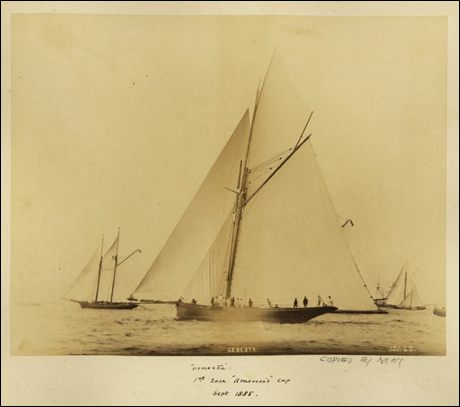
At this time the Puritan was sailing much better than the Genesta. She stood up stiff as a church, with her sails drawing like a team of elephants. The Genesta, on the other hand, was rolling badly and constantly spilling the wind out of her mainsail and club topsail. At the same time she was going steadily to leeward, while the Puritan was steering straight after the exclamation point that stood for the logging tug. All this while the Luckenbach was behind the yachts, puffing and blowing and churning frantically in her efforts to catch up. The Sandy Hook Lightship was already astern and the dome of the great hotel at Rockaway was just discernible upon the dip of the horizon to the northeast. The yachts were flying through the water at the rate of 10 miles an hour, but as the Luckenbach was making over 13 miles she overhauled them surely, if slowly.
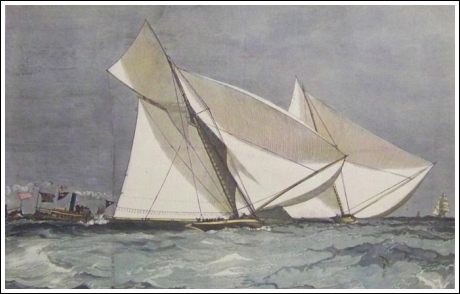
During this time it was an exceedingly difficult matter for those on board the Luckenbach to determine which yacht was ahead. The partisans of each thought as their hopes inclined them, and the two sets of eyes gazing at the same objects saw very different things. To one set of eyes it was plain that the Genesta was ahead, while the other set saw equally plainly that the Puritan was leading. The controversy waxed hotter and hotter, until at last at 11:45 the Luckenbach got abreast of the Genesta to the leeward, and it then became manifest even to her stoutest champions that the Puritan was ahead of her. The Puritan's lead was not very great -not more than a quarter of a mile- but it was enough to show that she was going through the water faster and enough to give promise of a decisive lead at the turning point.
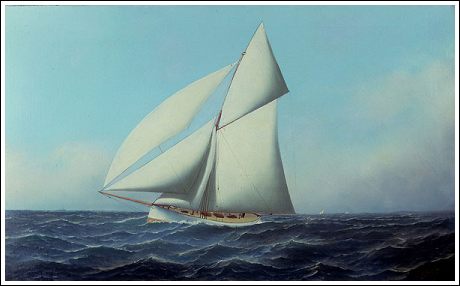
The Puritan had taken in her balloon jib top-sail, as it was of no use, and it only served to interfere with the drawing of her spinnaker. The Genesta still held on to her little jib topsail, and as it just covered the gap between the top of the spinnaker and the club topsail. It was a neat device of Skipper Carter to catch the wind spilled out of the bigger sail. It had hardly been remarked and commented on when, as If dissatisfied with it, the skipper took it in. At 11:58:45 the Genesta’s spinnaker suddenly fell flat against her head sails, and exclamations burst forth from many persons on the Luckenbach, who thought she had carried away something. But nothing was wrong about the cutter. The Englishman, being a man of resources, was simply trying one of the many little expedients he had learned in the course of his long and varied racing career, for snatching victory from defeat. He was merely taking in his spinnaker for the purpose of jibing his mainsail to starboard and resetting the auxiliary sail to port. He saw that by so doing he could make both sails draw better, and therein lay his only chance of reaching the outer mark before the Yankee. The cutter’s spinnaker pole is several feet longer than her mainmast, and consequently cannot be swung under the guys of her head sails. In order therefore to shift it from starboard to port, it had to be unfastened at the foot and lifted bodily foot foremost over to the port side. All this had to be done before the mainsail could be jibed, yet so handy were the English sailors that at 12:02:30, less than four minutes after the spinnaker was taken in, the mainsail was jibed, and in three minutes fifteen seconds more the spinnaker was reset on the port side and was pulling like a locomotive.
Up to this time all bad gone merrily for the American sloop. But now a change began to come over the complexion of the race. The time was 12:06, an hour had elapsed since the start, and the racers had gone over half of the outward course. So far the gain was altogether with the Puritan. But it speedily become apparent that the Genesta‘s sails were drawing better than the Puritan's, and that she was rapidly coming up on the sloop.
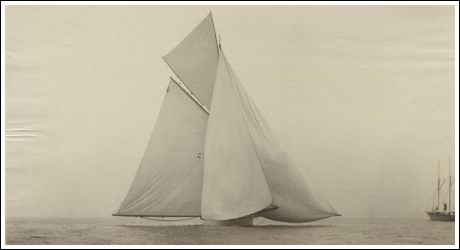
The friends of the sloop wondered why her skipper could not see the improvement the shifting of sails had made in the cutter's pace and avail himself of the example she set. The tug Scandinavian having logged off the course had anchored the buoy and come to a standstill, and was rising rapidly to the proportions of a respectable vessel. Yet the cutter, which had been astern three-fourths of the run was new showing her nose to the front as if she meant to round the mark ahead after all.
The wind had for some time been freshening, but its growing strength was imperceptible, owing to the furious pace at which the tug was flying before it. The thirteenth hour was drawing to a close, and the sky to the west and north-west was darkening as if a squall were in the air. The smaller steamboats and the sailing vessels that had been following the racers observed the signs in the heavens and turned their prows homeward, but the racers flew onward. It was not theirs to mind the gathering storm. The Genesta’s skipper, however, had been keeping his weather eye about him, and at 12:50 o‘clock he took down his big club topsail, and a few minutes afterward sent up a smaller sprit topsail. The Puritan quickly followed the Genesta’s example, taking in her club, but she did not set another topsail. As the minutes sped without another topsail going up on the American sloop her crew were accused of tardiness, but it eventually dawned on observers that her skipper did not intend to set a topsail. |
|
The Genesta was already ahead of the Puritan when the latter’s topsail came down. Deprived of this aid the Puritan fell rapidly behind, and when her skipper capped the climax by taking in his spinnaker nearly a mile away from the turning point, she was handicapped in a way that made her friends sick at heart. It was the first time in all her races that she had been poorly handled, and it seemed particularly unfortunate, not to say exasperating, to have the blunder come in a critical race. Up to this point in the race, with the exception of the clever manoeuvre executed at the start, all the management had been with the cutter, and all the sailing with the sloop. Still the sloop men did not despair, for those of them who had seen her sail in a breeze of wind and a sea felt a serene assurance that in the windward work the cutter would being match for her.
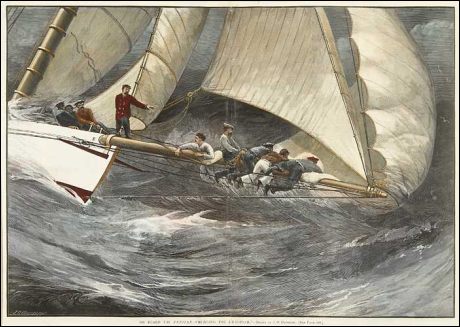
The Genesta rounded the outer mark at 1:05:30, made a neat turn, hauled close on the wind, and went off west by south half south, with the wind on her starboard hand. There was an outburst of applause by steam and a gun or two as the cutter went round, but there was an evident want of enthusiasm about it. The Puritan rounded the mark at 1:07:36. 2 minutes and 8 seconds behind the Genesta, which had beaten her 1 minute 21 seconds on the run out. She did not make as neat a turn as the cutter, but she soon showed her neatness in a far more serviceable manner.
Now the steamers and tugs turned their noses into the wind, and it was suddenly discovered by the spectators that there was a breeze upon the ocean. The sea was not rough as yet, but there were plenty of whitecaps and indications already of a rising chop. Once on the wind the sloop immediately began to outfoot as well as to outpoint the cutter, and in a little while, besides eating out to the windward, had materially narrowed the gap. When she went about on the port tack at 1:24, and was followed 30 seconds later by the Genesta, she was still behind, but not half so much so as when she rounded the buoy. At 1:26 she housed her topmast, and at 1:35 the Genesta taking in her sprit topsail gave rise to the conjecture that she also was about to house hers. But she wasn't. Instead of the sprit she set a working topsail and held on to it thereafter, as if her skipper believed that in it lay his only hope of success.
The wind, freshening every moment, was blowing a gale before 2 o’clock, and the cutter was having all the wind and weather her advocates have been so heartily praying for. The wind strengthened until it was blowing 37 miles an hour. It lashed the ocean into a fury of foam and fairly lifted great sheets of spray clean off the waves and carried them hundreds of feet. Every tug was wallowing frightfully in the choppy sea, enveloped in spray and encircled by rainbows. The Luckenbach was pitching furiously, shipping tons of water, and occasionally sending a stray hogsheadful clear across her deckhouse to deluge the unfortunate reporters, who, debarred from the pilot house by the committee and locked out of the cabin, were forced to take refuge under the lee side of the house.
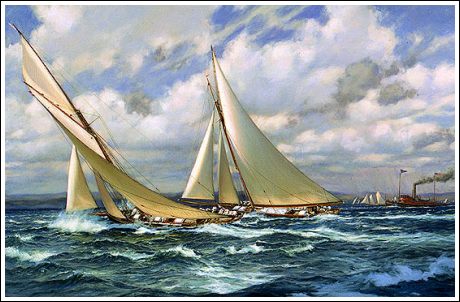
This was cutter weather with a vengeance, yet the sloop was working to the windward of her, walking away from her in a truly wonderful manner. In fact, besides running fully a mile ahead, she had nearly winded her on the same tack, as she did the Priscilla in the windward race off Sandy Hook several weeks ago. She was already well forward of the cutter‘s lee bow, and would soon have been on her weather bow, if the tack had lasted much longer, but the wind had hauled to northwest by north, and, both boats being well in toward the Long Island shore, the cutter’s skipper discovered that he could lay his course for the lightship, and at 2:16 went about on the starboard tack and stood for that mark. The Puritan was fully a mile further northward, yet she held on to the port tack two minutes longer, and lost all of that time as well as the distance between herself and the cutter. The yachts were then far to the east of Long Beach, yet they held on this tack clear to the lightship.
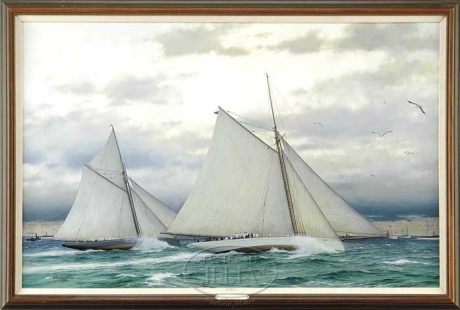
The Puritan gradually freed her sheets and ran down on a line converging with that followed by the cutter. She was heading into the seas, and she cleft them and leaped over them and sent sheets of foam on either side and showers of spray flying down the wind, but she did not bury half as badly as the cutter, which laid over on her port side until there was water several feet deep in her lee waist. It was a magnificent exhibition of sailing for fully 15 miles on one reach, and all that time the sloop was steadily overreaching the cutter. The Luckenbach had difficulty in keeping ahead of the Genesta, and the big steamer Columbia was unable to keep up with the Puritan. The Puritan overhauled the Luckenbach almost as fast as she overhauled the cutter. At last, head on the Sandy Hook Lightship and the Scotland, she ran down on the cutter and passed her to windward. The cutter made a futile attempt to luff for the purpose of keeping her from passing, but the sloop sped by her like the wind and finished fully a third of a mile ahead. The Luckenbach had not come to a stand abreast of the lightship more than two minutes when the Puritan crossed the line. It is no exaggeration to say that the Puritan beat the cutter three times in the race, and actually therefore sailed all around her. She finished at 4:09:15, 1 minute 24 seconds ahead of the Genesta, which finished at 4:10:39. She beat her 3 minutes 30 seconds in the windward work, 2 minutes 9 seconds over the course, and 1 minute 38 seconds on corrected time.
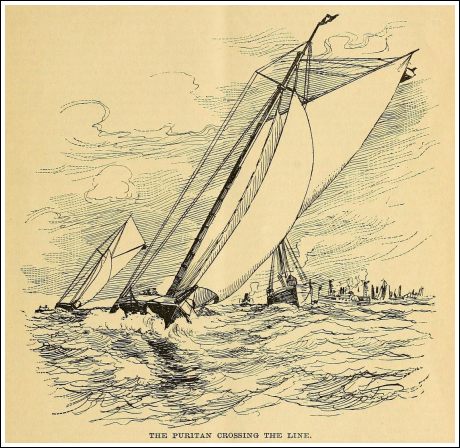
The official record of the race is as follows:
| |
Start. |
Finish. |
Actual
Times. |
Corrected
Times. |
| |
H. |
M. |
S. |
H. |
M. |
S. |
H. |
M. |
S. |
H. |
M. |
S. |
| Puritan |
11 |
06 |
01 |
4 |
09 |
15 |
5 |
03 |
14 |
5 |
03 |
14 |
| Genesta |
11 |
05 |
16 |
4 |
10 |
39 |
5 |
05 |
23 |
5 |
04 |
52 |

|
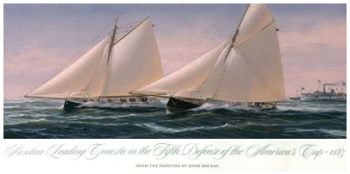 THE CUP TO REMAIN HERE !
THE CUP TO REMAIN HERE !